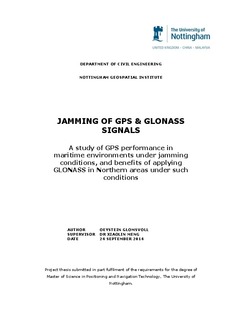| dc.description.abstract | Growing dependence on Global Navigation Satellite System (GNSS), especially GPS, for positioning and navigation at sea has raised a concern about the potential risks of signal interference. Technology for jamming is easily available, and in recent years there have been many cases of intentional jamming.
As GPS is the principal means of position fixing used by the Norwegian Navy, important questions to find answers to is how vulnerable the GPS and the Electronic Chart Display and Information System (ECDIS) are to a jamming attack, and further whether employing the Glonass satellite system in addition to GPS will provide better performance regarding robustness and redundancy when receivers are exposed to jamming. By having a Coast Guard Vessel operating inshore the Norwegian fjords as case, this research aims to explore these issues and it does so by asking the following research questions:
- Will employing Glonass in addition to GPS provide better performance in Northern areas when the systems are exposed to GNSS jammers?
- How is the ability of the existing GPS system on board a Norwegian Coastguard Vessel to provide a reliable position when there is a jamming threat, and how will the ECDIS system on board handle an eventually loss of GPS position?
The study consists of two jamming tests: A static test where focus is to analyze and compare the GPS and Glonass system and a dynamic test where the GPS and ECDIS system on board is analyzed when exposed to jamming.
The results from the static test showed that the jammer has effect on large distances, and that the different receivers used react differently when exposed to jamming. Further, the carrier-to-noise ratios for Glonass are less affected by the jammer, and the receiver is able to track Glonass satellites with lower carrier-to-noise ratios than GPS satellites. We have seen that utilizing Glonass satellites in addition to GPS satellites in the receiver contribute to a later loss of position fix and an earlier calculation of new position under difficult jamming conditions.
The dynamic test showed that the marine grade GPS receiver is easy to jam. A weak jamming signal caused the GPS receivers to give misleading information without any warning from itself or the ECDIS system. The ECDIS system provided an adequate DR positioning, but there are issues that need to be resolved for better functionality.
As Glonass signals has shown to be more resistant to jamming than GPS signals, applying the Glonass system in addition to GPS might provide benefits with regards to reliability and redundancy, especially for maritime navigation in Northern areas where the Glonass satellites also have higher elevation and better coverage than GPS. | nb_NO |
